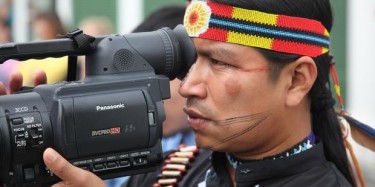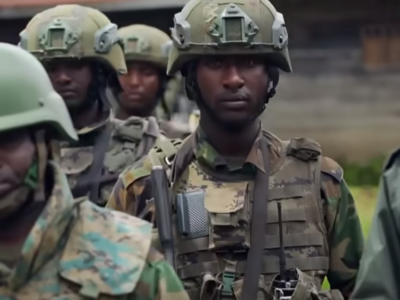[All links are to Spanish-language pages unless otherwise noted.]
Eriberto Benedicto Gualinga Montalvo is the head of Selvas Productions and the director of the documentary “Children of the Jaguar“, winner of two film festival prizes: the National Geographic's award for best documentary and Columbia's Indigenous Festival prize for best depiction of a struggle by an indigenous people.
The documentary follows the lives of the inhabitants of Sarayaku in the southern Amazonic region of Ecuador and their fight against multinationals [En] seeking to exploit oil reserves beneath the Amazon forest floor. Eriberto filmed the documentary over a six-month period, from June to December 2011, in Sarayaku in the province of Pastaza [En]. The work has been screened in a number of venues such as the National Geographic All Roads Film Festival, Colombia's Indigenous Peoples’ Film and Video Festival, Ecuador's EDOC (Encounters of the Other Cinema) Festival, and the Brussels International Film Festival.

Eriberto Benedicto Gualinga, director of the documentary “Children of the Jaguar”. Photo: Redes indígenas.
Global Voices: Why is the film titled “Children of the Jaguar”?
Eriberto: Mi familia viene de una descendencia de un shamán, que podía convertirse en tigre; el jaguar lucha hasta la muerte por defender su espacio de vida, es por eso que Sarayaku dice que son los descendientes del jaguar.
Eriberto: My family are the descendants of a shaman who could transform himself into a jaguar–the jaguar fights until death to defend his living space–that is why the Sarayaku people consider themselves children of the jaguar.
GV: What stands out most in this film?
E. G: El viaje de la delegación de Sarayaku, hacia la sede de Costa Rica para hacer respetar sus derechos [humanos y los derechos de otras muchas comunidades] frente al estado de Ecuador.
E.G.: The trip by the Sarayaku delegation to the seat [of the court] in Costa Rica to have their rights [human rights and the rights of many other communities] respected by the Government of Ecuador.
GV: What caught your attention the most when it came time to film?
E. G: La preparación, los testimonios, el viaje que hizo Sarayaku, ya que algunos ni siquiera conocían la capital del Ecuador, menos un avión, y muchos menos se imaginaban lo que era un juicio en la sede de la corte en Costa Rica.
E.G.: The planning, the testimony, the trip by the Sarayaku people, some of whom had never even been to the capital of Ecuador, much less on an airplane; and even fewer of them could have imagined what a trial in the seat of the Court [of Human rights] in Costa Rica would be like.
GV: Who were the main and supporting actors?
E. G: Los miembros que viajaron hacia Costa Rica. Los narradores fuimos Eriberto Gualinga (realizador), Patricia Gualinga (dirigente de la mujer y familia) Ena Santi (testigo).
E.G.: The members [of the community] who travelled to Costa Rica. The narrators were myself, Eriberto Gualinga (director), Patricia Gualinga (in charge of women and family) and Ena Santi (witness).
GV: Did you have to overcome any hurdles?
E. G: [Sí], los gastos de financiamiento, son un obstáculo para cualquier producción que quiera realizar un pueblo originario.
E.G.: [Yes], the financing costs are a challenge for any production undertaken by indigenous people.
GV: From a cinematographic perspective, how was the experience of making this documentary?
E. G: A más de filmar en el pueblo, tuve que filmar en otros escenarios, [como] fuera del país [con] otras realidades, enriqueciendo así el conocimiento artístico y personal.
E.G.: In addition to filming in the village, I had to film in other settings, [like] outside the country [with] different realities, thereby enriching artistic and personal awareness.
GV: How do you feel about the recognition you received at National Geographics’ All Roads Film Project in the best documentary category?
E. G: Cada reconocimiento es un incentivo para seguir haciendo más obras a favor de los pueblos originarios. [Uno se] siente con más energía y en paz consigo mismo al saber que su trabajo es tomado en cuenta y reconocido.
E.G.: Any recognition is an incentive to keep working on behalf of indigenous peoples. [One] feels more energized and at peace with oneself knowing that one's work is taken into account and recognized.
GV: What projects to you have in mind now?
E.G.: Trabajar en el siguiente video KAWSAK SACHA selvas vivientes, y hacer entender a la sociedad a través del video en la selva [que] existen otros seres similares a nosotros (seres espirituales), que son los dueños de la Selva y están en constante comunicación con nosotros a través de los shamanes.
E.G.: Working on the next video KAWSAK SACHA living jungles; and to explain to society by means of the video in the jungle [that] there exist beings similar to ourselves (spiritual beings) who are the keepers of the Jungle, and that they are continuously communicating with us through the shamans.
Sarayaku, is located in the eastern province of Pastaza in the Amazon Region of Ecuador. “Children of the Jaguar”, a documentary that depicts the daily resistance of the inhabitants of this village, is a testament to a free community that stands firm in its defence of the Amazon forest. So far, the ruling by the international body has not yet been implemented.
On 18 December 2012, Eriberto Gualinga received the Award for International Recognition, conferred on him by Ecuador's Ministry of Culture for the film “Children of the Jaguar”.






